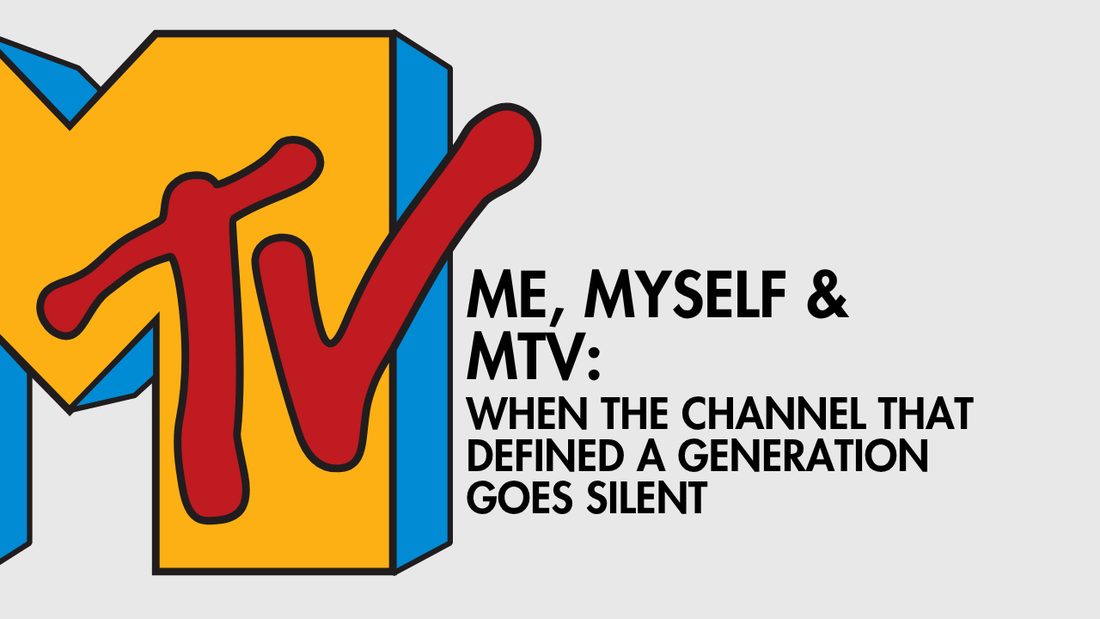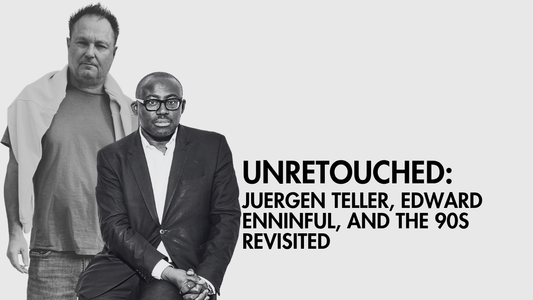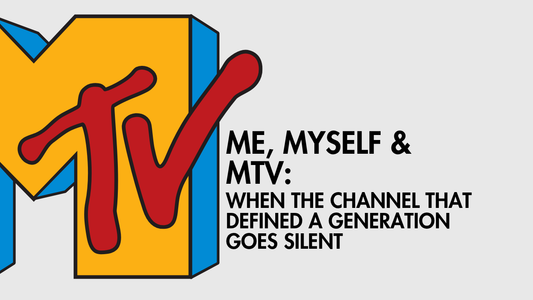
Me, Myself & MTV
Share

Written by Massimo Casagrande
When the channel that defined a generation goes silent.
“Does MTV still exist?” That was my first reaction when I read that MTV was shutting
down its European music channels. Slowly, a wave of nostalgia hit. Then came the
realisation that something bigger was ending: a shared ritual that shaped not just
how we listened to music, but how we understood ourselves. For my generation
MTV wasn’t just a TV channel, it was the place where we discovered who we were.
To be honest, MTV only arrived in Italy in the late ’90s, long after it had already
transformed pop culture elsewhere. But we had all heard and read about. We all had
that one cousin or friend who holidayed in the US and came back with MTV filled
stories.
Before that, we’d had a decade of VideoMusic, our own local attempt at a 24-hour
music channel, whose first video clip ever played was Lionel Richie’s All night Long ,
Club Tropicana (Wham!), and Radio Ga Ga (Queen). A new era was upon us in Italy.
Despite it’s modest, a la mano appearance, compared to MTV’s slick animated
aesthetic, VideoMusic shaped many of our musical tastes and introduced ideas to
Italy that we would not have otherwise known.
Then, on the 1st September 1997, everything changed: MTV finally launched. The “I
want my MTV” slogan became part of our vernacular. Broadcast from London, the
world suddenly felt closer. The music, the fashion, even the slang, it all arrived
through that small TV screen. Ah, and the VJs!
At that time, the Italian VJs were based in Camden Town. They were effortlessly
cool, full of attitude, fluent in pop culture, the bridges between our teenage
bedrooms, (or kitchen table in my case), and the rest of the world. Their accents had
that perfect MTV blend that made even a simple “ciao ragazzi” sound like a passport
to somewhere cooler. They spoke perfect English, but with that unmistakable hint of
Italian-ness that made everything sound a little more stylish, a little more ours. We all
wanted to be a VJ. They became iconic, they were our first crushes!
Thanks to MTV we were introduced to subcultures some of us had never heard of,
from grunge to hip-hop, via Britpop and techno. Watching MTV Brand New or
Unplugged was a crash course in aesthetics and emotion. You didn’t just hear about
new bands; you saw them perform live. For me, Nirvana’s Unplugged in New York,
the first thing transmitted on MTV Italy, remains, one of the most honest, intimate,
raw, and powerful cultural moments I’ve witnessed.
MTV didn’t just broadcast music; it broadcast aspiration. It taught us how to be seen,
how to perform, how to belong to a world that was moving faster than we were. It’s
strange to think that an entire generation learned aesthetics, self-expression, even
confidence, from a television channel.
With MTV came what I often think of as the second Americanisation of Italy; through
music videos, pop icons, and the global youth culture of the late ’90s. It wasn’t
imposed; it was aspirational.
The videos themselves were portals that connected us to fashion, subcultures, and
attitude. They weren’t just visuals, they were moodboards for how to dress, move,
exist, and lets be honest, the cause of many of our fashion faux pas! I’m definitely
guilty of that. For us, fashion and music had become inseparable. It made us dream
in colour but also taught us what cool looked like; an education in taste that shaped
how we judged ourselves and others.
There was also a profound sense of community. That shared experience of waiting
for a video premiere, recording it, and talking about it the next day. I remember
attending Total Request Live in Piazza San Babila, later moved to Corso Vittorio
Emanuele, in Milan. Or MTV Day, these weren’t just concerts, they were collective
moments.
Daria, Beavis and Butt-Head, and The Real World were shows that helped shape
our sense of identity, and defining the humour, irony, and introspection of our
generation. They reflected our 90s youth culture; messy, funny, and authentic,
something today’s hyper-curated feeds rarely are. They also gave voice to youth in a
way Italian television rarely did, no other channel was made entirely by young people
speaking directly to other young people.
I Want My MTV
And for me, there’s a personal connection too.
I still remember watching All Saints perform on MTV and, not long after, seeing them
perform live at my first Versus show at the Rolling Stone Club in Milano. Or back in
October 2000, while working at Versace, Britney Spears, one of MTV’s brightest
icons at the time was in town for her Oops!... I Did It Again world tour, which
happened to coincide with Milano Fashion Week, and Donatella seated me next to
her for dinner. From seeing her on MTV, miming to her songs, to passing her the salt.
That was iconic for me.
And a moment that felt surreal was seeing Robbie Williams wearing pieces I had
designed for the Versus menswear collection in one of his music videos.
To me if felt that MTV wasn’t just part of pop culture, it had become part of my own
story.
But somewhere along the way, reality TV killed the video star. The MTV that once
defined a generation shifted its focus to reality shows. It moved from discovering
artists to creating personalities. The dream changed, and no one wanted to be a VJ,
but a reality star. What youth aspired to shifted, the aesthetic of aspiration
transformed too: less about authenticity, more about visibility.
It's not my nostalgia talking, the whole ecosystem has changed. Today’s youth are
discovering music through algorithms: YouTube, TikTok, and other streaming
platforms. The access is easier, the range wider, but the sense of community is
fractured, the magic feels different. There’s no longer that collective ritual of tuning in
at the same time, waiting for your favourite song, or finding out who made number
one that week. Music has become more personal, but maybe less shared. Even
artists are dropping singles rather than releasing albums. The whole industry has
shifted.
Music has never been more present. It fills every platform, every feed, yet
somewhere along the way, the music video, once the purest expression of sound
and image, stopped being the heartbeat of pop culture and has quietly lost its
cultural pulse.
Even the biggest artists who once built their entire identity through video now often
release singles without any visual at all. Isn’t it ironic (sorry, Alanis!), that in an age
ruled by images, the format that once defined them all has lost its magic? As
Télérama wrote, “it’s the end of an era when music was listened to with the eyes.”
A world where four minutes of video could change everything has faded from
collective memory. The age when a single clip could define a generation, from Vogue
to Smells Like Teen Spirit, Richard Ashcroft’s endless walk in Bitter Sweet
Symphony, to Kylie’s iconic white jumpsuit in Can’t Get You Out of My Head, has
simply passed. (You can’t imagine my pain in only citing four examples!)
Still, for those like me who grew up with MTV, it remains part of our creative DNA. It
taught us that music was never just about sound, it was about identity, expression,
and community. It shaped how we dressed, how we moved, and how we imagined
the future. As Rolling Stone Italia put it, MTV, “was a temple where youth culture
reinvented itself every day.”
For us, MTV will always be more than a logo. It taught us one essential thing: that
music could be seen, not just heard. It was our mirror and our stage, the place where
creativity met conversation and culture felt alive, spontaneous, and global. Maybe
that version of MTV is gone, but its spirit continues in every visual artist, designer,
and dreamer who once sat in front of a screen thinking, I want to be part of that
world.
As for me? I’ll be somewhere with The Cardigans on repeat, channeling Nina
Persson (well, trying to), in My Favourite Game, music loud and no algorithm in
sight, riding quietly into the sunset of a generation that once lived through music
television.
Maybe that’s the real legacy of MTV, not the music videos, but the confidence it gave
us to shape our own soundtrack, one frame at a time.



